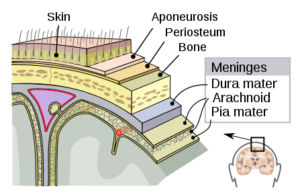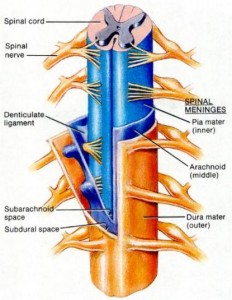What does it mean to have a tight nervous system?
The nervous system runs the show. Our central nervous system (CNS) takes in and processes information in a myriad of ways, before relaying that information to the rest of the body, through the peripheral nervous system (PNS). The CNS is the brain and spinal cord, and the PNS is all the nerves that emanate from the spinal cord to the rest of the body.
The brain and spinal cord are enveloped by three membranes called the meninges which serve to protect the brain and spinal cord, help to circulate the cerebrospinal fluid, and also support the flow of blood to the brain. The three meninges are the pia mater, the arachnoid mater, and the dura mater.
Not only does the spinal cord pass through the vertebral canal, it attaches to it as well. The meninges attach firmly to the skull and at the base of the spine on the tailbone. They attach loosely at four different places along the spine through fairly lax ligaments.
This relates to the tight nervous system comment at the top of the post. I was mentioning types of posture to my chiropractor, the extraordinary Lisa Kirsch, and she thought that one of them (a certain kind of forward head posture) resembled the manifestation of tight meninges. It took me a while to get my head around such a thing but eventually I did.
The meninges are connective tissue and though they might not have the elasticity of muscle they are susceptible to the tightening and dysfunction to which all fascia is prone. Fascia is the meat of the Rolfing/ myofascial release world and I am a big believer in the efficacy of such bodywork.
Everything for me always returns to posture. The spinal cord passes through the canal within the vertebral column. While this hole within the spine protects the spinal cord and meninges from injury, poor alignment of the spine can have far reaching effects on the nervous system, especially if the nervous system in the form of the meninges attaches directly to the spine.
Our bones hold us up, our muscles move us and the nerves tell the muscles to move the bones. This is one of my most repeated mantras. When the bones and thereby the spine are held up correctly two things happen. The muscles around the spine relax and the meninges hang perfectly in the spinal canal. Any aberration in the spine is going to cause tension between the secure connection of the meninges at the top and bottom of the spine. The looser connections in the middle of the spine might go with the flow but the top and bottom where the meninges connect tightly will be adversely affected.
For some this quality of the meninges being tight is a possible reason for migraines. And the lead story in the Times this morning is about an outbreak of meningitis that they are considering to be the result of too many epidurals—the pain relieving technique where cortisone injections numb pain for women during childbirth and people with back pain.
I always return to good bony alignment and balanced muscle tone so we can live harmoniously in space. The literal connection of the nervous system into our skeletal system should be reason enough to start changing the way you walk and stand.
***


